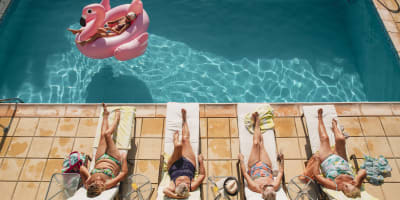We may earn commission from links on this page, but we only recommend products we believe in. Pricing and availability are subject to change.
A buying guide to the bestselling Hoka sneakers: Which pairs are best for your needs?
We're always on the hunt for sneakers that will keep our aches and pains at bay. We're talking foot pain, hip pain, and, of course, back pain. There's so much that goes into picking a perfect pair of sneakers, including how and when you plan to wear them. We can't help but take notice of a shoe brand that starts to go viral with shoppers old and young adding them to their carts. That's exactly what happened with Hoka sneakers not too long ago, and we simply needed to see for ourselves.
Hoka Transport
Best Hoka sneaker for travel
Hoka Clifton 9
Best walking sneaker from Hoka
Hoka Bondi 8
Best extra cushioned sneaker from Hoka
Hoka Stinson 7
Best off-road walking sneakers from Hoka
Hoka Gaviota 5
Best sneakers from Hoka with extra stability
Hoka Ora Recovery Slide 3
Best Hoka sandal
Hoka Ora Recovery Shoe 2
Best everday sneaker from Hoka
Last year, a member of our research team took a trip to Disneyland and wore a Hoka Clifton pair and could not rave enough at the result. "They were the only shoes that didn't exacerbate my plantar fasciitis," she shared. That got us thinking about these ultra-cushioned sneakers quite a bit. The bigger the brand got, the more options became available and the more beloved they became by shoppers, podiatrists, and even celebrities. They are synonymous with comfort and with their often brightly colored options, they're hard to miss. The wide variety of styles, however, can make it a challenge to know what's best for you and your specific needs.
That's where we come in. Our research team spoke to podiatrists and other experts to understand which Hoka was best for all types of walking, from exercise to everyday walking.
The best Hoka shoes for walking
Sizes: 5 to 11 | Colors: 7 | Type of shoe: Sneakers
- Excellent traction
- Waterproof available
- Toggle laces for easy on and off
- Limited colors
Sizes: 5 to 12 | Colors: 21 | Type of shoe: Sneakers
- Supportive
- Waterproof option available
- Tons of colors
- Wide sizes available
- Some shoppers find them snug/narrow
Sizes: 5 to 12 | Colors: 17 | Type of shoe: Sneakers
- Wide sizes available
- Multiple color options
- Lightwieght
- Super-cushioned
- Excellent traction
- Expensive
Sizes: 5 to 11 | Colors: 7 | Type of shoe: Trail runners
- Excellent traction
- Stabilizing
- Supportive
- Reinforced toe cap
- Limited colors
- More expensive
Sizes: 5 to 12 | Colors: 10 | Type of shoe: Sneakers
- Wide sizes available
- Stabilizing
- Plush insoles
- Supportive
- More expensive
Sizes: 5 to 16 | Colors: 30 | Type of shoe: Slides
- Supportive
- Unisex
- Lots of color options
- More affordable
- No half sizes
Hoka Gaviotas has a stabilizing frame that cradles the foot to prevent it from rolling. They also feature a plush tongue and collar, and an ultra-cushioned insole for added comfort.
Sizes: 5 to 11 | Colors: 4 | Type of shoe: Slip-on sneakers
- More affordable
- Easy slip-on and off
- Vegan
- Supportive
- Good shock absorption
- No half sizes
- Limited colors
How our research team chose the best Hoka shoes
To figure out which Hokas were the best of the best, we consulted brand insiders, podiatrists, hiking enthusiasts and our own shopping editors. They weighed in on what to look for when picking the right style for your specific needs. We also polled this crew to find out which Hokas are their favorites — because there's nothing like a firsthand recommendation!
The best Hokas for walking FAQs
What are the key considerations when choosing a walking shoe?
Support: Supportive walking shoes are a must, especially when it comes to arches. The sole shouldn't twist too much, and the shoe should provide stability with every step.
Comfort: Features like extra cushioning, memory foam insoles and breathable uppers are all important in walking shoes.
Durability: With apologies to Nancy Sinatra, these shoes are made for walking. You need a pair that's built to withstand plenty of strolls and won't wear out after a few uses.
Weight: If you're trying to get your steps in, the last thing you want is a pair of heavy shoes weighing you down. Most Hokas weigh less than a pound.
Fit: A walking shoe should be wide enough for you to splay your toes for better balance and stability, but it should still be snug enough to prevent your foot from rolling while you walk.
Can you wear Hoka shoes every day?
Whenever we ask podiatrists to list their favorite shoes, Hokas are almost always mentioned because of how comfortable and supportive they are for everyday wear. Brenner told us she loves the brand because it meets "all the criteria of a supportive shoe. I especially like that they make their shoes with the EVA material for shock absorption."
Many Hokas have also earned the American Podiatric Medical Association Seal of Acceptance. This means they have been reviewed and approved by podiatrists to ensure they promote foot health, so you can feel good about wearing them daily.
What sets Hoka shoes apart from other walking shoes?
If you've ever seen a pair of Hokas, you know about the thick, cushioned midsole. The shoes are also designed to work as an ultra-comfortable shock absorber that doesn't weigh you down. Meanwhile, the foot frame cradles your foot to offer extra support and keep it in place no matter the terrain. As for the MetaRocker, Smith explained it like this: "It's a curved shoe geometry that complements the natural gait cycle. It can be dialed up to create a faster transition in the forefoot or dialed down to provide more ground contact and stability."
Meet our experts
Dr. Hillary Brenner, a New York-based podiatric surgeon
Cris Hazzard, hiking expert with HikingGuy.com
Jared Smith, Hoka product line manager
Verna Volker, ultra-marathoner and Hoka ambassador
Dr. Polina Zaydenberg, a New York City-based podiatrist






